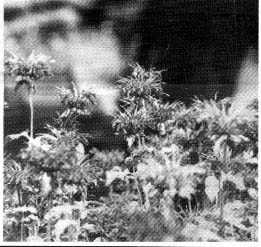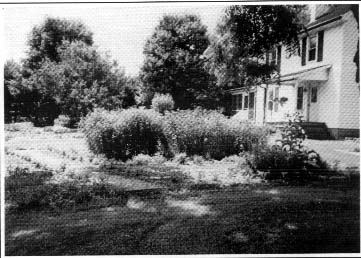
Bee Balm
Click Here to Return to Milestones

When planning a historical garden the most important thing to remember is accuracy. This is why research is so important. Get to know the historical period (colonial, medieval, Victorian, etc.) that your garden will portray. Study old herbals, history books, journals, garden books, visit historical sites, and seek advice from local historians, herbalists, and horticulturists.
To plan any garden, formal or informal, do some homework with pencil, paper, and measuring tape. Go outside and map out your entire yard. Include trees, shrubs, perennial flowers, Planning Historical Garden fences, houses, outbuildings, etc. Be sure to mark any shaded area or wetland. Your map should include the time of day the sun hits each section of the yard because most herbs require full sun and well drained soil. Some herbs that thrive in partial or total shade include wormwood, sweet woodruff and certain mints.
When you have sketched in building locations, trees, and shrubs on your scale drawing, you are ready to go back indoors. Settle back with a cup of herbal tea, decide what thcme gardcn would be right for you and start planning.
Layout the garden on graph paper. Start a garden journal and keep notes of heights and spread of plants, how they grow under different conditions, did a neighboring plant affect a plant's growth and what type of good and bad bugs visited your garden? These questions are important to have happy, healthy herbs.
Traditionally gardens were grown in straight rows. Today circles within squares, triangles, short rows, long rows, curved or straight - will give your herb garden an interest, an inner beauty, different from other gardens. A herb garden lends itself to tailored arrangements - beds of plants in geometric design, precise, clipped borders (such as germander, thyme, hyssop etc.), weedless areas neatly mulched or graveled and ample pathways giving room for both work and enjoyment.
If you choose a perennial garden keep in mind the plants will be left permanently in their location. You must know the height and spread of the plant because perennial herbs will get their size the second year, so give them plenty of room to expand. Add annual herbs and flowers to a perennial garden for instant color. Perennials can be divided about every three years or exchanged for a new plant when they become too woody and unproductive.
When designing your garden, be sure to include herbs that have different leaf shapes and flowers. A well planned garden should please both your own fancy and that of your herbs.
Cook's Garden - To plan an herb garden, start with herbs you are already familiar with. If you enjoy creating new recipes or cooking with fresh herbs, consider growing your own Cook's Garden. You have to consider what kind of food you enjoy - American, Italian, Greek, Mexican, French, Thai, etc. Then plan your garden accordingly. Choose herbs that will be compatible to your tastes.
Herbs found in a Cook's garden include basil, savory, lemon balm, lemon verbena, sage, thyme, coriander, chervil, anise, cumin, mint, burnet, Italian parsley, curled parsley, Greek oregano, French tarragon, dill, nasturiums, lemon gem marigolds, rose scented geraniums, lemon grass, lavender, chives, and hyssop.
Herbs and vegetables make good companions in a Cook's Garden if done properly. But it is important to remember that not all plants grow well beside enemy herbs. Depending on weather, soil, etc., certain herbs have proven to be bad neighbors to vegetables.
While larkspur loves cabbage, it hates beets, turnips and potatoes. If you want a good onion crop, be sure to keep any type of sage far away. Sage will help cabbage, tomatoes, sweet marjoram and feverfew.
Colonial Gardens - A colonial housewife knew the importance of the garden. She used herbs for dyes, medicines, and food. Many colonial housewives knew that sickly plants recovered if chamomile, the plant's physician, was cultivated nearby and that somehow combinations like beans and savory, potatoes and horseradish, cabbage and mints planted in adjacent garden rows gave healthy, pest-free results.
During the Boston Tea Party, bee balm tea was consumed by the colonists. The pink flowers and leaves are brewed for a taste similar to black tea with a hint of mint. Bee balm graced many a colonial garden.
Colonial housewives used herbs for making dyes. ne young leaves of woad make a light blue dye, while mature leaves yields a darker blue. Indigo is one of the oldest and most reliable dyes for wool, silk, cotton and linen. In Beaver County, indigo is a tender perennial and must be moved indoors for winter.
Bloodroot and henna are important herbs for obtaining red dyes. Bloodroot can be used fresh or dried, the result is a scarlet red color. Henna yields a beautiful orange-red dye on wool, hair and fabrics. It is one of our oldest and best dye botanicals. Henna should be grown in large containers and wintered over indoors.
Other favorite colonial herbs include peppermint, spearmint, violas, burnet, leeks, parsley, savory, chives, lemon balm, caraway, anise hyssop, horehound, rue, comftey, angelica, hyssop, tansy, and feverfew.
Tea Gardens - A Tea Garden is really something very personal. You must decide what flavors appeal to you the most and choose herbs accordingly. For example, if you love mints try apple mint, pineapple mint, and for you chocolate lovers, try chocolate mint! If your taste buds prefer the taste of lemon try lemon balm, lemon verbena or lemon thyme.
Early pioneers knew a cup of chamomile tea helped an upset stomach. For the onset of colds, a weak brew of common sage was drunk until the symptoms passed. Parsley tea is full of Vitamin C and is a good source of iron. Other herbs brewed by early gardeners included common mints, boneset, burnet, summer savory, and thyme.
When planning your garden remember some of the herbs used by pioneers are no longer considered safe for culinary use. When reading early herbals, be sure to check with an experienced herbalist before trying some concoctions mentioned. Tansy and cornfrey were considered medicinal herbs and eaten freely and tea consumed almost daily by early herbalists like Culpepper. Today they are considered dangerous and toxic and should not be ingested.
When your garden is complete on paper, it is time to go outside and stake out the garden. After the danger of frost, then you are ready to plant your herb garden.
Karen Helbling is a certified herbalist (with a goal of becoming a Master Herbalist). She teaches on and off their farm where her and her husband, Mark, grow over 290 different types of herbs. She is a frequent guest on Party Line, a three-hour talk show on WBBW in Youngstown, Ohio.

Their farm, on Little Beaver Road, Enon Valley, Pa., is a family-owned and operated business dedicated to growing quality herbs, vegetables and flowers.
The Greenhouses open May 1 and offer over 500 varieties of herbs, specialty and everlasting flowers, bedding plants, scented geraniums, and vegetable plants. Miniature rose bushes are also available.
The Country Craft and Gift Shop is open year round. Featured are dried herbs, jellies, pumpkin butter, teas, dried flowers, soaps, wreaths, doorswags, and other handcrafted herbal products made on the farm.
The Farm Market offers a wide variety of naturally grown vegetables and herbs in season.
The Green Thumb Herbal School offers workshops for adults and children from ages 7-14. Call for details on upcoming workshops. Off farm lectures offered.
Display gardens can be toured from June through September. Group tours and luncheons available by appointment. Buses are welcome.
Farm hours are: Mon.-Sat. 9 a.m. to 7 p.m.
and Sunday, noon to 5 p.m. Closed Thanksgiving, Christmas, New
Year's Day and Easter Call (412) 336-FARM for directions.